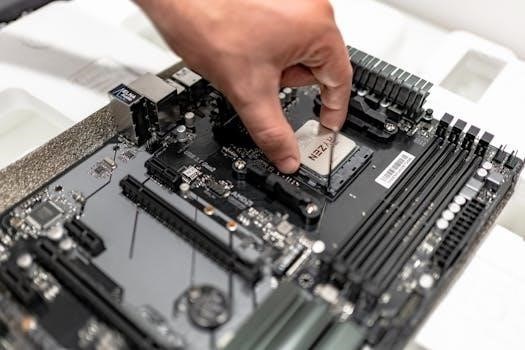The Honeywell XNX Universal Transmitter is designed for global hazardous area use, offering flexible installation. It supports various sensing technologies, allowing local or remote sensor attachments. This manual provides essential guidelines.
Overview of the Honeywell XNX Transmitter
The Honeywell XNX Universal Transmitter is a versatile device designed for use in hazardous areas worldwide. It offers a robust platform for various gas detection applications. Its design incorporates five threaded ports, providing ultimate installation flexibility. The transmitter is compatible with a wide array of sensing technologies, allowing for both local and remote sensor mounting. The device is typically mounted using integral tabs, offering diverse mounting options. It’s crucial to consult the appropriate manuals prior to installation and commissioning. The XNX is supported by comprehensive documentation including technical and safety manuals.
Safety Precautions Before Installation
Prior to installing the XNX transmitter, it is essential to carefully review the XNX safety manual (1998-0808). Ensure compliance with all relevant safety protocols and standards.
Review of the XNX Safety Manual (1998-0808)
Before commencing any installation work on the XNX transmitter, a thorough review of the safety manual, document number 1998-0808, is absolutely mandatory. This manual contains critical information regarding safe handling, installation procedures, and potential hazards associated with the device. It details necessary precautions to take to prevent accidents, ensuring a secure environment for both the installer and the equipment. Familiarize yourself with all safety warnings, cautions, and specific instructions outlined in this document. Ignoring these guidelines may lead to serious risks. Always prioritize safety and adhere strictly to the manual’s recommendations. This step is crucial for the safe and efficient operation of the XNX transmitter.

Mounting the XNX Transmitter
The XNX transmitter offers versatile mounting options using integral tabs. These tabs allow the device to be attached in various configurations, ensuring adaptability to different installation environments.
Various Mounting Methods Using Integral Tabs
The XNX Universal Transmitter is designed with integral mounting tabs that provide a multitude of mounting options, ensuring flexibility in diverse industrial settings. These tabs enable secure attachment to various surfaces, whether it’s a wall, a pipe, or other structural elements. The design allows for easy adjustments and repositioning during installation. This adaptability ensures the transmitter can be placed in the optimal location for accurate gas detection. The integral tabs simplify the mounting process, reducing installation time and effort. This feature contributes to the overall ease of use and practicality of the XNX transmitter in different operational environments. The robust design of the tabs ensures a stable and reliable mounting solution.

Wiring and Connections
Certified M25 cable glands are essential for secure wiring. Shielded armoured cable is recommended. Refer to wiring diagrams for correct power supply connections. Proper wiring ensures safe operation.
Use of Certified M25 Cable Glands
The installation of the XNX transmitter mandates the exclusive use of certified M25 cable glands. This requirement is crucial for maintaining the integrity of the transmitter’s hazardous area certifications. These glands provide a secure and robust seal, preventing the ingress of moisture, dust, and other contaminants that could compromise the device’s performance and safety. Employing certified glands ensures that the electrical connections remain protected and compliant with industry standards, thereby mitigating risks associated with improper wiring. Always verify that the cable glands are correctly installed, tightened, and suitable for the environment in which the XNX transmitter is being deployed. This attention to detail is vital for the longevity and reliable operation of the system.
Power Supply and Wiring Diagrams
Proper power supply connections are essential for the reliable operation of the XNX transmitter. Refer to the specific wiring diagrams provided in the XNX Universal Transmitter technical manual, part number 1998M0738, before commencing any electrical work. These diagrams detail the correct polarity and voltage requirements for the device. Incorrect wiring can lead to damage or malfunction, potentially jeopardizing safety. It is crucial to adhere strictly to the specified guidelines for connecting both the power source and the signal outputs. Shielded armored cable is recommended to minimize electrical interference and ensure signal integrity. Always double-check the connections before applying power to the transmitter to avoid any potential issues.

Sensor Installation and Compatibility
The XNX transmitter supports various sensors, including electrochemical, Sensepoint, and Searchline Excel types. Refer to respective manuals for specific installation procedures and ensure proper compatibility before use.
Electrochemical Sensor Installation
For electrochemical sensor installation with the XNX transmitter, consult the dedicated section within the XNX Universal Transmitter Technical Manual. This section outlines the specific steps required for proper mounting and connection of electrochemical sensors. It also details any specific considerations for these sensors, ensuring accurate and reliable gas detection. Refer to the XNX Universal Transmitter Resource CD (1998-0748) for comprehensive instructions. This will provide detailed diagrams and necessary precautions to maintain optimal sensor performance and longevity. Ensure correct alignment and secure connections are made for reliable operation. Always follow the safety guidelines provided in the manual.
Compatibility with Other Sensor Types (Sensepoint, Searchline Excel)
The XNX transmitter demonstrates compatibility with various sensor types, including Sensepoint and Searchline Excel models. For specific installation details related to these sensors, refer to their individual manuals. The XNX Universal Transmitter Resource CD (1998-0748) contains links and references to these manuals. It is crucial to consult the correct documentation for each sensor to ensure proper connection, configuration, and calibration with the XNX transmitter. Compatibility ensures seamless integration and accurate readings across different sensor technologies. This allows for flexible use within various applications. Always follow the manufacturer’s guidelines.

Configuration and Setup
For detailed configuration, consult the XNX Universal Transmitter Resource CD, part number 1998-0748. This resource provides comprehensive documents for proper setup and commissioning of the transmitter.
Referencing the XNX Universal Transmitter Resource CD (1998-0748)
Before initiating the installation or commissioning of the XNX transmitter, it is imperative to consult the XNX Universal Transmitter Resource CD, identified by Honeywell part number 1998-0748. This comprehensive resource contains critical documentation essential for proper setup and operation. The CD includes detailed technical manuals, safety guidelines, wiring diagrams, and configuration procedures. Accessing and understanding this information is crucial for ensuring the safe and effective use of the XNX transmitter. It is advisable to review all relevant documents on the CD before proceeding with any physical installation or configuration tasks. This step helps in avoiding potential issues and ensures compliance with safety standards.
Troubleshooting
For basic troubleshooting, refer to the XNX manual. It contains tips to help resolve common issues. Always follow safety guidelines during troubleshooting procedures.
Basic Troubleshooting Tips
When facing issues with your XNX transmitter, begin by checking all wiring connections to ensure they are secure and correctly placed, referencing the appropriate wiring diagrams in the manual. Verify that the power supply is providing the correct voltage and that the transmitter is receiving power. Inspect the sensor connections for any signs of damage or corrosion, ensuring proper attachment. Consult the XNX Universal Transmitter Resource CD for comprehensive troubleshooting guides and error code interpretations. Additionally, check if the transmitter is within its operating temperature range and environment to prevent any unexpected malfunctions. If problems persist, contact technical support for assistance.
Maintenance and Proof Testing
Maintaining the XNX’s functional safety requires regular proof tests, as outlined in the manual. These procedures ensure the transmitter operates correctly in low demand applications, and should be done routinely.
Proof Test Procedure for Functional Safety
The proof test procedure is crucial for maintaining the XNX transmitter’s functional safety, especially in low-demand applications. This process, detailed within the technical manual, verifies the operational integrity of the device. It involves a systematic check of the transmitter’s various functions, ensuring it responds correctly to simulated alarm conditions. Regularly performing this test, as outlined in the manual, is essential to meet safety standards and maintain the reliability of the gas detection system. The specific steps and intervals for the proof test are provided in the XNX documentation, and following them is paramount for continued safe operation. Failure to conduct these tests can compromise the system’s ability to detect gas leaks and could lead to unsafe conditions;
